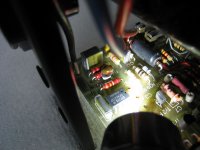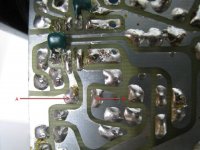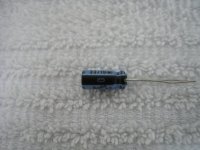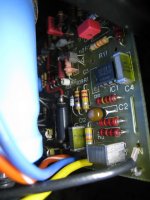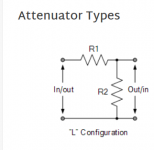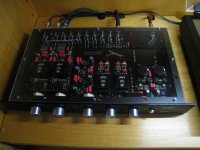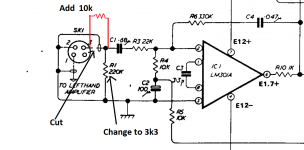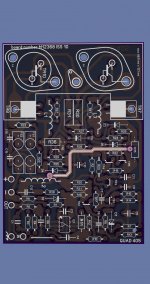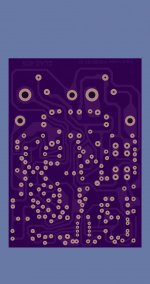I think you will find one end of the cap goes to ground and in the original Quad C2 was fitted with the cap negative to ground.
I would advise you to measure the DC voltage across the present cap and fit a replacement according to what you measure so that it is polarised correctly. Assuming your C2 corresponds to those in the original service manuals then the voltage across the cap is going to be of the order of millivolts.
I would advise you to measure the DC voltage across the present cap and fit a replacement according to what you measure so that it is polarised correctly. Assuming your C2 corresponds to those in the original service manuals then the voltage across the cap is going to be of the order of millivolts.
I want to replace C2 in my QUAD 405 but I do not see polarity markings on the boards.
The C2 is a nfb unity gain cap, and there is no correct polarity for it.
Normally any DC voltage across it should be small, but in the event of
a failure somewhere in the amp, it could be much larger.
I'd use a non-polarized 100uf, 25V-50V electrolytic, if one will fit.
Last edited:
I want to lower input sensitivity to 1.5V. I will be replacing C2 [I think it is 100 µF] for all versions but I do not know what version do I have] with a 33 µF cap. I will also replace R4 which is 22K Ω with a 4.7K Ω resistor.
Looking at the attached photo, which one is ground A or B?
Thanks,
Looking at the attached photo, which one is ground A or B?
Thanks,
Attachments
Last edited:
Just do a continuity check on your meter to see which is ground.
You need to be very very careful altering components. I'd would have to study the circuit closely but R4 appears to set the 'noise gain' of the opamp stage. In other words its another way of compensating the stage. Altering R4 won't alter the gain of the amp at all.
Much safer (and simpler) to just use a simple attenuator at the input
You need to be very very careful altering components. I'd would have to study the circuit closely but R4 appears to set the 'noise gain' of the opamp stage. In other words its another way of compensating the stage. Altering R4 won't alter the gain of the amp at all.
Much safer (and simpler) to just use a simple attenuator at the input
C2 is used as an integrator in conjunction with R5. Reducing its value to 33uf isn't a good idea.
Just a simple attenuator (two series resistors) in front of the amplifier.
Passive Attenuator Tutorial about Passive Attenuators
A lot depends on the preamp you are driving all this with. If its a modern design with low impedance output then use something like a 10k and 3k3 and see how that works subjectively. Then either increase or decrease the 3k3 to get the desired level. R1 would be the 10k
Passive Attenuator Tutorial about Passive Attenuators
A lot depends on the preamp you are driving all this with. If its a modern design with low impedance output then use something like a 10k and 3k3 and see how that works subjectively. Then either increase or decrease the 3k3 to get the desired level. R1 would be the 10k
Attachments
It is easy to built, but will increase the noise level. I am using a Klyne LXP3/P preamplifier with phono.
The noise from a simple attenuator is nothing to worry over.
The 405 input stage is definitely not a low noise design (by todays thinking) with its very high front end feedback resistor values wrapped around an opamp (R3/R6).
What I'm getting at with the preamp is whether it will drive a load of say 10k correctly. Any solid state design worth its money will, a valve job probably would not.
I'm not familiar with the Klyne and couldn't turn anything much up 🙂
Looking at the Quad and you probably could reduce the sensitivity but I wouldn't like to do that without trying it for real. R6 would need to be lowered (gain of that stage is R6/R3) and C4 increased correspondingly to maintain the same lower frequency cutoff point.
Stability is the big question. R4 effectively increases the noise gain of the opamp and that can be used as a means of compensation but you would need to do detailed testing to see how it all behaved. You might need a combination of techniques to maintain the original performance. I noticed you had an OPA627 fitted which makes all this even more important.
That's why the simple attenuator is safest.
The 405 input stage is definitely not a low noise design (by todays thinking) with its very high front end feedback resistor values wrapped around an opamp (R3/R6).
What I'm getting at with the preamp is whether it will drive a load of say 10k correctly. Any solid state design worth its money will, a valve job probably would not.
I'm not familiar with the Klyne and couldn't turn anything much up 🙂
Looking at the Quad and you probably could reduce the sensitivity but I wouldn't like to do that without trying it for real. R6 would need to be lowered (gain of that stage is R6/R3) and C4 increased correspondingly to maintain the same lower frequency cutoff point.
Stability is the big question. R4 effectively increases the noise gain of the opamp and that can be used as a means of compensation but you would need to do detailed testing to see how it all behaved. You might need a combination of techniques to maintain the original performance. I noticed you had an OPA627 fitted which makes all this even more important.
That's why the simple attenuator is safest.
The Klyne is a very rare preamp but no longer manufactured. I have the owners manual but there are no specifications listed, it has a separate PS. I called Stan Klyne and left a message on his answering machine but I doubt he will call me back. Please see photograph.
Attachments
I think that I was making too much fuss [much ado about nothing] because the Klyne was designed to give optimum results at 700mv and works fine with my Electrocompaniet AW100. I don't think that there is much difference between the Klyne and the 405 which has 500mv.
Best regards,
Best regards,
As long as it all works correctly, and just as importantly the 'feel' and range of the volume control is OK then you should be fine. If it goes from zero to full volume in a quarter turn of the control, well that's when you need to think about an attenuator.
Enjoy 🙂
Enjoy 🙂
The Klyne's volume control has 21 positions, I used it between 5 and 7 with a pair of Aerial 10T [86dB, same as ESL 63] which I no longer have.
I had three pairs of QUAD ESL 63, the first one arrived from my friend Nick's shop [Chew and Osborne] in Essex in 1981. Then, in between, I had other makes, some were outstanding but I still missed the Quads. Then, last year I bought another pair of ESL 63 and took them to Quads Unlimited in Central Florida for total rebuild but they are still at the shop since last November. The owner had a car accident plus many health issues to deal with and plenty of work. He is probably the best rebuilder of Quads this side of the Atlantic.
I have to be patient.
Thanks for taking the time to educate me.
Bes regards,
Horacio
I had three pairs of QUAD ESL 63, the first one arrived from my friend Nick's shop [Chew and Osborne] in Essex in 1981. Then, in between, I had other makes, some were outstanding but I still missed the Quads. Then, last year I bought another pair of ESL 63 and took them to Quads Unlimited in Central Florida for total rebuild but they are still at the shop since last November. The owner had a car accident plus many health issues to deal with and plenty of work. He is probably the best rebuilder of Quads this side of the Atlantic.
I have to be patient.
Thanks for taking the time to educate me.
Bes regards,
Horacio
hello guys I have a question, I clone the Quad 405 PCB board number M12368 ISS 10 you guys think is it worthy to try out this older PCB ? I was reading that the newest last board is Quad 405 board number M12565-7 see images of the cloned PCB
Regards
Juan
Regards
Juan
Attachments
No idea tbh 🙂
If the circuitry is identical, then you would need to research what the actually board differences are and make a judgement call on that.
If the circuitry is identical, then you would need to research what the actually board differences are and make a judgement call on that.
The Quad 405 have too much gain for many applications. Reducing the gain will also reduce the noise floor. In many cases a gain redaction of 10 dB or even more work fine. You can read more at Keith Snook's homepage. Reducing the gain will also improve sound quality.
The Quad 405 have too much gain for many applications. Reducing the gain will also reduce the noise floor. In many cases a gain redaction of 10 dB or even more work fine. You can read more at Keith Snook's homepage. Reducing the gain will also improve sound quality.
thanks sir, I will check that out
- Status
- Not open for further replies.
- Home
- Amplifiers
- Solid State
- QUAD 405 C2 polarity
